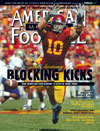AMERICAN FOOTBALL MONTHLY THE #1 RESOURCE FOR FOOTBALL COACHES
Article CategoriesAFM Magazine
|
Blocking Kicks - The Take Off, Bend and ApproachHow Montclair State blocked 29 kicks in three yearsby: Mike Kuchar © More from this issue Think special teams isn’t as vital a part of the game as offense and defense? You ever sit back and think about what type of effect Appalachian State’s win over Michigan last year in the Big House had on the landscape of college football? Sure, Big Blue rebounded to have a productive season. What Appalachian State did on that Saturday afternoon in early September was not only pull off a made-for-TV Hollywood style upset, but it got every coach who was fortunate enough to be watching that game on TV scratching their heads thinking, “Am I really seeing this? Did a Division I-AA school just knock off a top-25 team?” They did, and they did it with special teams by blocking two field goals. What’s worse (for Michigan fans) is that App State predicted it. Coach Jerry Moore, through film study, detected a weakness in the Wolverines f....The full article can only be seen by subscribers. Subscribe today!
|
|
|||||||
| HOME |
MAGAZINE |
SUBSCRIBE | ONLINE COLUMNISTS | COACHING VIDEOS |
Copyright 2026, AmericanFootballMonthly.com
All Rights Reserved





